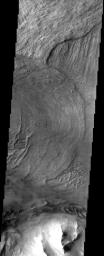
|
Mariner 9 Anniversary/Landslides on Mars (Released 13 November 2002)
- Click the image above for a larger view
- Full-Res JPEG (1237 x 3043) (772.3 kB)
- Full-Res TIFF (1237 x 3043) (3.5 MB)
Caption:
November 13, 1971 is a red-letter date in the history of exploration. Thirty-one years ago today the American spacecraft, Mariner 9, became the first spacecraft to orbit another planet. Imagery from three previous flyby Mariner Missions (4, 6, and 7) indicated that Mars looked similar to the Earth's Moon (craters and plains). However, Mariner 9's eleven month mission mapped the whole planet with over 7,000 images. This mission rewrote the book on Mars by discovering channels, polar layered materials, enormous shield volcanoes, sand dunes, and an enormous canyon system. This canyon system, Valles Marineris, was named in honor of its discoverer. Therefore, in honor of Mariner 9, the THEMIS Team is releasing an image of a portion of Valles Marineris called Melas Chasma. Melas Chasma comprises the central portion of the Valles Marineris canyon system complex. A series of massive landslides are visible on the canyon floor. The older (bottom-most) landslide has longitudinal ridges which formed parallel to flow direction, while the younger slides have concentric ridges. Dunes are also visible near the bottom of the image.
[Source: ASU THEMIS Science Team]
Note: this THEMIS visual image has not been radiometrically nor geometrically calibrated for this preliminary release. An empirical correction has been performed to remove instrumental effects. A linear shift has been applied in the cross-track and down-track direction to approximate spacecraft and planetary motion. Fully calibrated and geometrically projected images will be released through the Planetary Data System in accordance with Project policies at a later time.
Background Info:
NASA's Jet Propulsion Laboratory manages the 2001 Mars Odyssey mission for NASA's Office of Space Science, Washington, D.C. The Thermal Emission Imaging System (THEMIS) was developed by Arizona State University, Tempe, in collaboration with Raytheon Santa Barbara Remote Sensing. The THEMIS investigation is led by Dr. Philip Christensen at Arizona State University. Lockheed Martin Astronautics, Denver, is the prime contractor for the Odyssey project, and developed and built the orbiter. Mission operations are conducted jointly from Lockheed Martin and from JPL, a division of the California Institute of Technology in Pasadena.
Cataloging Keywords:
| Name | Value | Additional Values |
|---|---|---|
| Target | Mars | |
| System | ||
| Target Type | Planet | |
| Mission | 2001 Mars Odyssey | Mariner |
| Instrument Host | Mars Odyssey | |
| Host Type | Orbiter | Flyby Spacecraft |
| Instrument | Thermal Emission Imaging System (THEMIS) | |
| Detector | ||
| Extra Keywords | Crater, Dune, Grayscale, Moon, Thermal, Volcano | |
| Acquisition Date | ||
| Release Date | 2002-11-15 | |
| Date in Caption | 1971-11-13 | |
| Image Credit | NASA/JPL/Arizona State University | |
| Source | photojournal.jpl.nasa.gov/catalog/PIA04003 | |
| Identifier | PIA04003 | |
